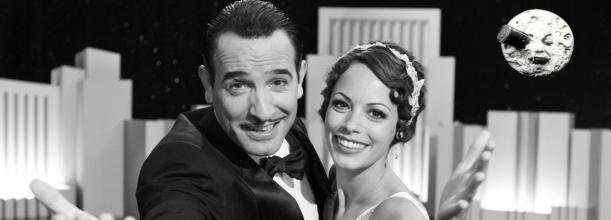Silent Cinema in the Digital Age

A new season is upon us. Milan fashion week has just showcased the new Autumn/Winter menswear collection, winter seems to have properly begun (February is in fact the coldest month of the year, lest we annually forget) and movie fans everywhere are licking their lips – it’s Oscar season.
Amidst the snubs (Ryan Gosling, Michael Fassbender, the dogs) and the hushed agreement that it is ‘Meryl’s time’, there are two films dominating the 2012 nominations. Martin Scorsese’s Hugo has been nominated a staggering 11 times, and Michel Hazanavicius’ The Artist received 10 nominations. Both are films which owe a debt to the age of silent cinema.

Whilst The Artist borrows the conventions that define the silent era, Hugo’s plot revolves around its most influential cinematic event: Georges Méliès’ Le Voyage dans la Lune. So significant is this 14 minute short, in which a group of astronomers partake in a surreal adventure to the moon, that its impact is still felt in 21st century pop culture. The image of a disgruntled moon with a rocket in its eye will forever remain iconic; Queen and The Smashing Pumpkins have paid tribute to it, and the idea of personifying our largest satellite inspired aspects of Baz Luhrmann’s Moulin Rouge and the BBC comedy series The Mighty Boosh. (Indeed, the Moon’s all-too-brief cameo was the only redeeming feature of Noel Fielding’s otherwise disappointing Luxury Comedy…)
Le Voyage… is one of the most important pieces of cinema history, and this granddaddy of the silent age has now been digitally restored in colour, with a soundtrack composed by French electronica duo Air – who have said their entire musical career has been inspired by the moon.
Clearly, silent cinema is proving that it still retains its charm. But if Hollywood decides that there is money to be made in following The Artist‘s example – and the relentless tide of prequels, sequels and remakes right now suggests that it probably will – then there is a disheartening paradox at work. A cinematic period defined by the flaws and flickers of projected film will be rebooted for the benefit of an audience for whom these visual quirks have been virtually eradicated. It’s somewhat ludicrous to see a homage to silent cinema accompanied by the word ‘digital’.

Silent cinema academic Cherchi Usai, who has dubbed the digital age the “death of cinema”, deemed the restored version of Méliès’ classic “appalling”. Soon, he said, the only way to watch the original versions of these films will be at a museum that cares to preserve them. And he’s probably right. I have yet to see Le Voyage dans la Lune – it feels like sacrilege to watch it on YouTube.
Yes, in 2012 it may prove unrealistic to expect to access silent cinema through its original format. But if you loved The Artist, please don’t wait for it to be destroyed with a Hollywood sequel – watch the likes of It and Pandora’s Box any way you can, if only to get a feel for the magical era to which Hazanavicius is paying tribute. If Bérénice Bejo does take home the Oscar for Best Supporting Actress, you’ll see how Clara Bow and Louise Brooks made it possible.





Recent Comments